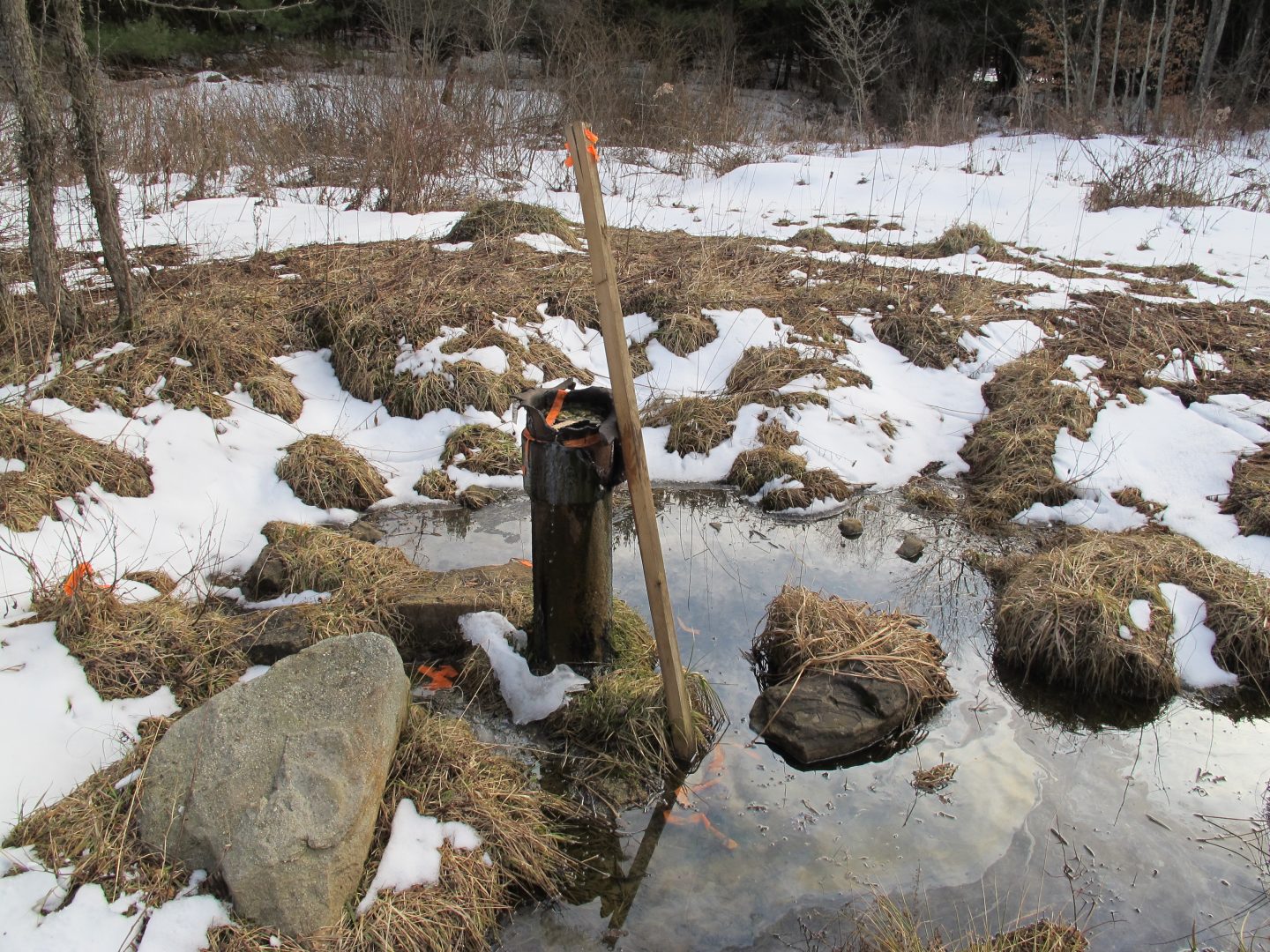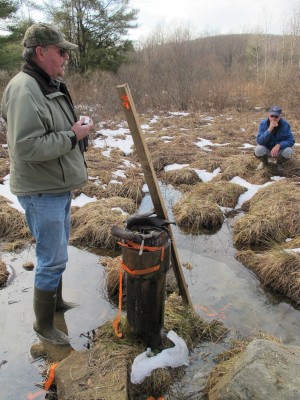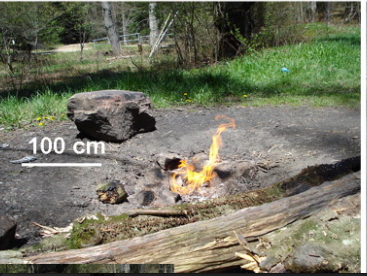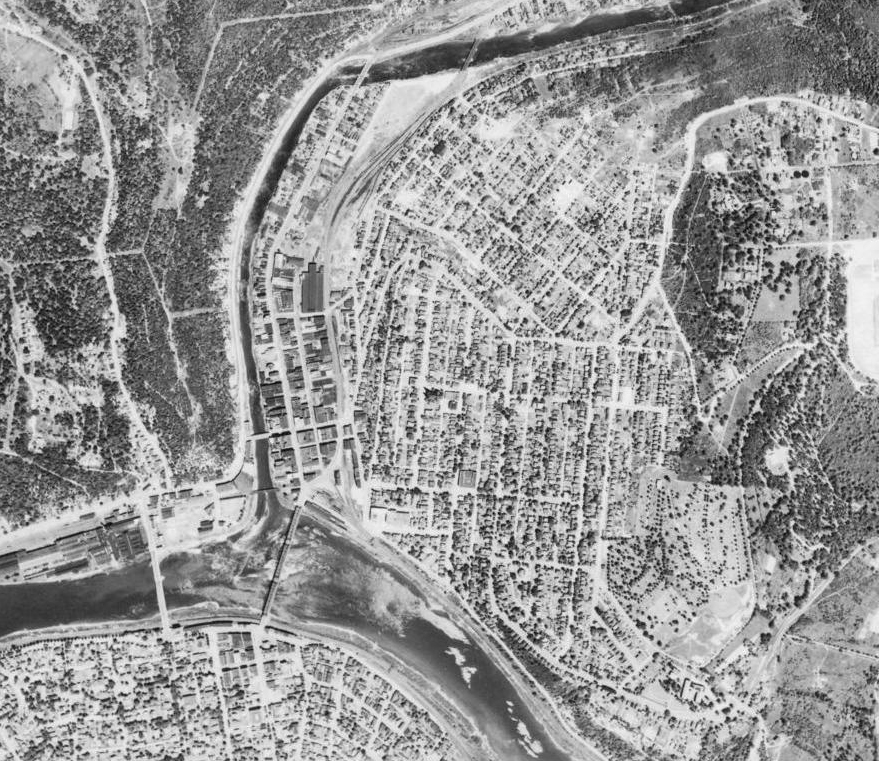
An abandoned well from the early 1900's spews oil into the Tamarack Swamp.
Susan Phillips / StateImpact Pennsylvania

An abandoned well from the early 1900's spews oil into the Tamarack Swamp.
Susan Phillips / StateImpact Pennsylvania

Susan Phillips / StateImpact Pennsylvania
An abandoned well from the early 1900's spews oil into the Tamarack Swamp.
(Pittsburgh) — By some accounts, Pennsylvania has the worst accumulation of old, unplugged, ownerless oil and gas wells in the nation. There are an estimated 200,000 of them, and the cost to plug them could exceed $6 billion.
The state’s orphan well plugging program has been underfunded for decades, but it is primed to take advantage of an influx of cash.
Part of President Joe Biden’s $2.3 trillion proposal to upgrade the nation’s infrastructure would dedicate $16 billion to reclaiming abandoned wells and mines across the U.S.
Cementing shut wells that were left behind during more than a century of drilling has emerged as a popular policy in the past year. It bridges environmental groups — who want to cap scattered hazards that leak brine, oil and methane, a powerful greenhouse gas — and oil and gas companies — who see it as a growth area for their business as drilling declines.
Biden plan would spend $16B to clean up old mines, oil wells
It isn’t certain that every item in the Biden administration’s sweeping infrastructure proposal will end up in final legislation before Congress or that a broad infrastructure bill will pass.
But “there appears to be bipartisan coast-to-coast support for stimulus for orphan well plugging and remediation,” said Adam Peltz, a senior attorney at the Environmental Defense Fund.
“There’s good reason for optimism that it will occur at some point this year.”

Susan Phillips / StateImpact Pennsylvania
Bill Peiffer checks out an abandoned oil well in the Tamarack Swamp in Warren County. Tom Savko sits in the distance.
Pennsylvania environmental regulators and the state’s conventional oil and gas industry have spent years drawing attention to the dire need for more funding and studying ways to plug vastly more abandoned wells.
The Department of Environmental Protection has lined up 500 priority and nearby wells that could be bid right away when stimulus funding arrives.
The federal money, if it comes through, would be “the opportunity of a lifetime,” said Seth Pelepko, environmental program manager at the oil and gas bureau.
“A lot of what we do right now is looking for sources of money, looking for partnerships,” he said. Instead, his six-person team could turn to executing a plugging program for the 8,700 verified wells on Pennsylvania’s abandoned wells list and identifying the several hundred thousand wells that are believed to be scattered around the state but not yet on the list.
Bills introduced in the U.S. House and Senate in recent weeks would dedicate between $5 billion and $8 billion to plugging orphan wells, with the bulk of the funds dispersed to states through grants administered by the Department of the Interior.
Both proposals include initial grants of up to $25 million to states with established well cleanup programs, like Pennsylvania, that can quickly sign contracts to use a surge of funding within months.
More money would then be sent to states to be spent over five years using formulas based on a state’s inventory of orphan wells and its recent oil and gas job losses.
The bills would also reward states with tens of millions of dollars in additional grants for pumping more state money into well plugging and strengthening regulations to prevent more wells from being abandoned.
Even a fraction of the proposed cash would be more money than Pennsylvania’s well plugging program has ever seen.
During its best funding year ever, in 2008, the department had $3.5 million to spend on plugging abandoned wells, in part because significant funding from the state’s Growing Greener environmental investment initiative was channeled to the program. Contractors plugged about 250 abandoned wells that year.
Now, the program is funded primarily by $150 to $250 surcharges on new well drilling permits — a fee rate the Legislature has not raised since 1992 — and plugging has slowed substantially.
DEP’s abandoned well plugging budget last year was $720,000.
Old wells may mean old tools
With its meager and unpredictable budget, Mr. Pelepko said, the agency has kept its focus on the “worst of the worst” wells — those that pose the greatest public health and environmental risks.
Emergency plugging projects often demand a large chunk of the available funding. DEP recently spent $350,000 to plug a single well in a front yard in Franklin Park that was releasing so much methane through the soil that workers could put a garbage bag on the ground and fill it up with the flammable gas, Mr. Pelepko said during a presentation in January.
For an average well, DEP’s well plugging costs are about $33,000.

Courtesy of Indiana University
An eternal flame the size of a campfire burns in Forest County. Researchers say the source is an old abandoned gas well.
Arthur Stewart, chairman of the Pennsylvania Grade Crude Development Advisory Council, said in northwestern Pennsylvania, where his company, Cameron Energy, is based, old wells can be plugged for $15,000 — as long as they are intact. But wells sitting idle, exposed to changing environmental conditions, can experience a devastating amount of decay. Often fishing obstructions out of abandoned wells takes up most of the labor before cement can be poured.
During a presentation to DEP’s Citizens Advisory Council in January, he showed a photo of a garage filled with racks of tools his company uses to plug old and abandoned wells. It looked like an exhibit from an industrial heritage museum.
“There are not many people in Pennsylvania let alone the world who still own tools like these to do the fishing that’s required to get to the bottom of these ancient wells,” he said.
Pennsylvania’s conventional oil and gas industry is especially well positioned to benefit from a large-scale abandoned well plugging program that will require the expertise of people accustomed to dealing with old tools and old wells. It is also eager to reverse a decade of decline before generational expertise is lost.
Companies — some startups, others industry veterans that once made a living drilling shallow wells before that work dried up in the past decade — are taking notice of the possibilities.
In 2020, veterans of Downtown-based shale gas giant EQT Corp. founded Next LVL Energy, which aims to be “the Appalachian Basin’s most specialized, efficient and cost-effective plugging service provider.”
Mr. Pelepko said he has seen smaller drilling companies refocus on the plugging opportunities as development drilling has slowed.
The department’s list of approved plugging contractors has grown from a handful to a few dozen in the past several years, in part because the agency made an effort to track down capable companies. That list will also give the agency a leg up when stimulus funding arrives, Mr. Pelepko said.
A plugging program could be an opportunity for oil and gas workers displaced during the recent downturn. DEP estimates that 300 jobs are created for every $25 million invested in abandoned well plugging.
Rob Greathouse started his plugging company, S&T Services & Supply, in 1988. For the first two decades, S&T was plugging about 250 wells a year. But in recent years that has dropped to just a few dozen “because all the easy ones are done,” he said.
Mr. Greathouse was working on a stubborn old well in Clarion County where freshwater had eaten through two layers of piping. He had been there for eight weeks, and the well was not yet ready to plug.
Since 2017, when he laid off eight people, Mr. Greathouse has been running his one rig, a converted 1950s Army truck, with his rig hand Allen Shrout. Work has been steady, he said, and while he heard contacts at DEP talking up the potential for a federal stimulus, Mr. Greathouse isn’t ramping up.
“They said there’s supposed to be a big chunk of money coming out,” he said. He’ll believe it when he sees it.

An aerial photo of Oil City, taken in 1937
Meanwhile, over the past decade, more than three times as many wells were added to the plugging list as were removed from it, said Scott Perry, DEP’s deputy secretary for the office of oil and gas management.
In fact, many more could be added each year. Mr. Stewart said in the mile radius around Cameron Energy’s office in Warren County there are “literally hundreds of orphan wells” that are not on the verified list.
One bottleneck in expanding the list is the legal research required to establish that known abandoned wells lack a viable owner. DEP is looking into contracting with an outside provider to speed up the process.
At the same time, evidence is growing that unplugged abandoned wells are a local economic hazard as well as an environmental and public safety one. It’s a factor that has “been missing from a lot of the conversation,” said Jeremy Weber, an associate professor at the University of Pittsburgh’s Graduate School of Public and International Affairs.
In a working paper that is under peer review, he and other Pitt researchers looked at historical well records and 50 years of property data from Washington County. They found that since 1970, the two acres around an average unplugged well had only half as much building as the two acres around a plugged well.
It’s a logical effect, Mr. Weber said. “Given that there’s oftentimes options for where to build, why would you deal with having to plug and reclaim a well site, that would probably be on your dime, if you didn’t have to? You might just pick another parcel.”
Those foregone building projects — most often outbuildings such as barns and garages but also homes — reduced real estate investment, which depressed property values.
The researchers found that properties around a typical unplugged well in Washington County had a market value that was 12% less than properties near plugged wells. And by constricting the tax base, unplugged wells reduced annual revenues by at least $112 per student in the McGuffey School District, which has the highest number of known unplugged wells in the county.
Although the researchers didn’t examine whether plugging an abandoned well spurs building, Mr. Weber said he expects that it would eventually make a difference.
In areas with a lot of abandoned wells, a plugging program “would be something that, over time, greases the wheels for building,” he said, “because now there are that many more parcels for which you don’t need to deal with a well.”

Get insights into WITF’s newsroom and an invitation to join in the pursuit of trustworthy journalism.
The days of journalism’s one-way street of simply producing stories for the public have long been over. Now, it’s time to find better ways to interact with you and ensure we meet your high standards of what a credible media organization should be.